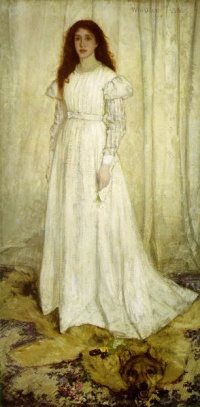Symphony in White, No. 1: The White Girl
From The Art and Popular Culture Encyclopedia
| Revision as of 17:19, 20 January 2008 Jahsonic (Talk | contribs) ← Previous diff |
Revision as of 12:33, 9 February 2013 Jahsonic (Talk | contribs) Next diff → |
||
| Line 1: | Line 1: | ||
| + | [[Image:Whistler, “Symphony in White, No.1 The White Girl, painted 1862.jpg|thumb|200px|right|[[James Whistler]]'s painting ''[[Symphony in White, No. 1: The White Girl]]'' ([[1862]]) caused [[controversy]] when exhibited in London and, later, at the ''[[Salon des Refusés]]'' in Paris. The painting epitomizes his theory that art should essentially be concerned with the beautiful arrangement of colors in harmony, not with the [[realism|accurate portrayal of the natural world]].]] | ||
| {{Template}} | {{Template}} | ||
| - | [[James Whistler]]'s painting ''[[The White Girl]]'' ([[1862]]) caused controversy when exhibited in London and, later, at the ''[[Salon des Refusés]]'' in Paris. The painting epitomizes his theory that art should essentially be concerned with the beautiful arrangement of colors in harmony, not with the [[realism|accurate portrayal of the natural world]]. | + | |
| + | '''''Symphony in White, No. 1''''', also known as '''''The White Girl''''', is a painting by [[James Abbott McNeill Whistler]]. The work shows a woman in full figure standing on a wolf skin in front of a white curtain with a lily in her hand. The colour scheme of the painting is almost entirely white. The model is [[Joanna Hiffernan]], the artist's mistress. Though the painting was originally called ''The White Girl'', Whistler later started calling it ''Symphony in White, No. 1''. By referring to his work in such abstract terms, he intended to emphasise his "[[art for art's sake]]" philosophy. | ||
| + | |||
| + | Whistler created the painting in the winter of 1861–62, though he later returned to it and made alterations. It was rejected both at the [[Royal Academy]] and at the ''[[Salon (Paris)|Salon]]'' in Paris, but eventually accepted at the ''[[Salon des Refusés]]'' in 1863. This exhibition also featured [[Édouard Manet]]'s famous ''[[Déjeuner sur l'herbe]]'', and together the two works gained a lot of attention. ''The White Girl'' shows clearly the influence of the [[Pre-Raphaelite Brotherhood]], with whom Whistler had recently come in contact. The painting has been interpreted by later art critics both as an allegory of innocence and its loss, and as a religious allusion to the [[Mary (mother of Jesus)|Virgin Mary]]. | ||
| + | |||
| + | |||
| {{GFDL}} | {{GFDL}} | ||
Revision as of 12:33, 9 February 2013

|
Related e |
|
Featured: |
Symphony in White, No. 1, also known as The White Girl, is a painting by James Abbott McNeill Whistler. The work shows a woman in full figure standing on a wolf skin in front of a white curtain with a lily in her hand. The colour scheme of the painting is almost entirely white. The model is Joanna Hiffernan, the artist's mistress. Though the painting was originally called The White Girl, Whistler later started calling it Symphony in White, No. 1. By referring to his work in such abstract terms, he intended to emphasise his "art for art's sake" philosophy.
Whistler created the painting in the winter of 1861–62, though he later returned to it and made alterations. It was rejected both at the Royal Academy and at the Salon in Paris, but eventually accepted at the Salon des Refusés in 1863. This exhibition also featured Édouard Manet's famous Déjeuner sur l'herbe, and together the two works gained a lot of attention. The White Girl shows clearly the influence of the Pre-Raphaelite Brotherhood, with whom Whistler had recently come in contact. The painting has been interpreted by later art critics both as an allegory of innocence and its loss, and as a religious allusion to the Virgin Mary.

